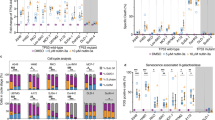Abstract
Chinese hamster ovary cells grown under conditions which are optimal for the production of a genetically engineered protein in batch culture, lose significant viability shortly after entering the stationary phase. This cell death was investigated morphologically and was found to be almost exclusively via apoptosi. Furthermore, cells were analyzed by flow cytometry using a fluorescent DNA end-labeling assay to label apoptotic cells, in conjunction with cell cycle analysis using propidium iodide. Apoptotic cells could be detected by this method, and by the radioactive end-labeling of extracted DNA, on all days of culture from day 1 to day 7; however, the degree of apoptotic cell death increased dramatically when the cells entered the stationary phase, rising to 50–60% of the total cell number at the termination of the culture. Flow cytometric analysis showed that the majority of cells underwent apoptosis whilst in G1/G0 and formed an apoptotic population with high DNA FITC end-labeling and hypodiploid propidium iodide binding. Additionally, the ability or inability to secrete specific protein products did not appear to interfere with the development of the apoptotic population with time.
Similar content being viewed by others
References
Arends MJ, Wyllie AH. (1991) Apoptosis: mechanisms and roles in pathology. Int. Rev. Exp Path. 32: 223–254.
de la Broise D, Noiseux M, Lemieux R and Massie B. (1991) Long term perfusion culture of hybridoma: a “grow or die” cell cycle system. Biotechnology and Bioengineering 38: 781–787.
Coco-Martin JM, Oberink JW, van der Velden-de Groot TAM and Beuvery EC. (1992) The potential of flow cytometric analysis for the characterization of hybridoma cells in suspension cultures. Cytotechnology 8: 65–74.
Cotter TG, Lennon SV, Glynn JG and Martin SJ. (1990) Cell death via apoptosis and its relationship to growth development and differentiation of both tumour and normal cells. Anticancer Research, 10: 1153–1160.
Dean PN and Jett JH. (1974) Mathematical analysis of DNA distribution derived from flow microfluorimetry. J. Cell Biol. 60: 423–527.
Dive C and Wyllie AH. (1993) In Hickman JA and Tritton TR. (eds), Frontiers in Pharmacology: Cancer Chemotherapy. Blackwell, Oxford, pp. 21–56.
Duke RC, Chervenak R and Cogen JJ. (1983) Endogenous endonuclease-induced DNA fragmentation: an early event in cell-mediated cytolysis. Proc Natl. Acad. Sci. USA 80: 6361–6365.
El Alaoui S, Main S, Lavery J, Quash G and Griffin M. (1992) Cell cycle kinetics, tissue transglutaminase and programmed cell death (apoptosis). FEBS 311: 174–178.
Franek F, Vomastek T and Dolníková J. (1992) Fragmented DNA and apoptotic bodies document the programmed way of cell death in hybridoma cultures. Cytotechnology 9: 117–123.
Goegen JL, Marc A and Engasser JM. (1993) Determination of cell lysis and death kinetics in continuous hybridoma cultures from the measurement of lactate dehydrogenase release. Cytotechnology 11: 189–195.
Gorczyca W, Bigman K, Midewman A, Ahmed T, Gong J, Melamed MR and Darzynkiewicz Z. (1993) Induction of DNA strand breaks associated with apoptosis during treatment of leukemias. Leukemia 7: 659–670.
Gorczyca EW, Bruno S, Darzynkiewicz RJ, Gong J and Darzynkiewicz Z. (1992) DNA strand breaks occurring during apoptosis: their early in situ detection by the terminal deoxynucleotidyl transferase and nick translation assays and prevention by serine protease inhibitors. International Journal of Oncology 1: 639–648.
Kaufmau RJ and Charp PA. (1982) Amplification and expression of sequences co-transfected with a modular dihydrofolate reductase complementary DNA gene. J. Mol. Biol. 159: 601–621.
Kerr JFK, Wyllie AH and Currie AH. (1972) Apoptosis, a basic biological phenomenon with wider implications in tissue kinetics. Brit. J. Cancer 26: 239–245.
Mercille S and Massie B. (1984) Induction of apoptosis in nutrient deprived cultures of hybridoma and myeloma cells. Abstract: “Applications of apoptosis” meeting, January 17th–19th La Jolla, California.
Moore JV. (1987) Death of cells and necrosis of tumours. In: Potten CS (ed) Perspectives in mammalian cell death. Oxford University Press, Oxford, pp 295–325.
Murray K, Ang CE, Gull K and Dickson AJ. (1993) Apoptotic cell death in CHO and myeloma cells: implications for recombinant protein expression, Japanese Animal Cell Culture Meeting, Abstract 1–107.
Schleager EJ and Simpson SD. (1994) Cell death (apoptosis) in cell culture. Abstract: “Applications of apoptosis” January 17th–19th La Jolla, California.
Schwartzman RA and Cidlowski JA. (1993) Mechanism of tissue-specific induction of internucleosomal deoxyribonucleic acid cleavage activity and apoptosis by glucocorticoids. Endocrinology 133: 591–599.
Singh RP, Al-Rubeai M, Gregory CD and Emery AN. (1994) Cell death processes in bioreactors. Abstract: “Applications of apoptosis” meeting, January 17th–19th La Jolla, California.
Suzuki E and Ollis DF. (1989) Cell cycle model for antibody production kinetics. Biotechn. Bioeng. 34: 1398.
Telford WG, King LE and Fraker PJ. (1991) Evaluation of glucocorticoid-induced DNA fragmentation in mouse thymocytes by flow cytometry. Cell Prolif. 24: 447–4599.
Telford WG, King LE and Fraker PJ. (1992) Comparative evaluation of several DNA binding dyes in the detection of apoptosis-associated chromatin degradation by flow cytometry 13: 137–143.
Urlaub G and Chasin LA. (1980) Isolation of Chinese hamster cell mutants deficient in dihydrofolate reductase activity. Proc. Natl. Acad. Sci. USA 77: 4216–4220.
Vomastek T and Franek F. (1993) Kinetics of development of spontaneous apoptosis in B cell hybridoma cultures. Immunology Letters 35: 19–24.
Wyllie AH. (1980) Glucocorticoid induced thymocyte apoptosis is associated with endogenous endonuclease activation. Nature 284: 555–556.
Wyllie AH. (1987) Apoptosis: cell death in tissue regulation. J. Pathol. 153: 313–316.
Wyllie AH, Kerr JFR and Currie AR. (1980) Cell death: the significance of apoptosis. Int. Rev. C tology 68: 251–306.
Author information
Authors and Affiliations
Rights and permissions
About this article
Cite this article
Moore, A., Donahue, C.J., Hooley, J. et al. Apoptosis in CHO cell batch cultures: examination by flow cytometry. Cytotechnology 17, 1–11 (1995). https://doi.org/10.1007/BF00749215
Received:
Accepted:
Issue Date:
DOI: https://doi.org/10.1007/BF00749215




